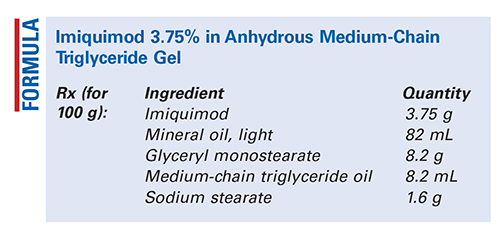US Pharm. 2022;47(8):58-59.

Method of Preparation: Calculate the required quantity of each ingredient for the total amount to be prepared. Accurately weigh or measure each ingredient. Using low heat, mix the glyceryl monostearate, medium-chain triglyceride (MCT) oil, and sodium stearate until homogeneous; add the imiquimod and mix well. Separately, heat the mineral oil to the same temperature. Combine the mixtures, mixing well, and cool to room temperature. Package in a light-resistant container and label.1
Use: Used in the treatment of external genital warts and actinic keratoses, topical imiquimod is also safe and effective for molluscum contagiosum in children.2
Packaging: Package in tight, light-resistant containers.
Labeling: Keep out of reach of children. Discard after ____ [time period]. Apply exact dose topically as prescribed. Keep away from eyes and mucous membranes. Not to be handled if pregnant.
Stability: A beyond-use date of up to 6 months may be used for this preparation.1
Quality Control: Quality-control assessment can include theoretical weight compared to actual weight, pH, specific gravity (SG), active drug assay, color, texture–surface, texture–spatula spread, appearance, feel, rheologic properties, and physical observations.3,4
Discussion: Imiquimod (Aldara, Zyclara, C14H16N4, MW 240.30) occurs as a white or almost white powder or crystalline powder. It is very slightly soluble in methanol and practically insoluble in water and acetone. Aldara 5% Cream (Valeant) and Zyclara 2.5% Cream (Medicis) contain parabens and benzyl alcohol, so the gel compound discussed here is useful for patients who cannot tolerate those ingredients. The other ingredients in the two commercial products are the same (cetyl alcohol, stearyl alcohol, and white petrolatum).1,5
Light mineral oil is a transparent, colorless, viscous liquid that is practically tasteless and odorless when cold. It has an SG of 0.818 to 0.880 and is insoluble in water or alcohol.6
Glyceryl monostearate (C21H42O4, MW 358.6) occurs as a white to cream-colored, waxlike solid in the form of beads, flakes, or powder. It is waxy to the touch and has a slight fatty odor and taste. The commercial products occur as mixtures of glyceryl monostearate and glyceryl monopalmitate. Glyceryl monostearate is used as an emollient, emulsifying agent, and solubilizing agent.7
MCT oil is the fixed oil extracted from the hard, dried fraction of the endosperm of Cocos nucifera L. or the dried endosperm of Elaeis guineensis Jacq. It consists of a mixture of triglycerides of saturated fatty acids—mainly caprylic acid and capric acid—and contains not less than 95% of saturated fatty acids. MCT oil occurs as a colorless to slightly yellowish, oily liquid that is practically odorless and tasteless and solidifies at about 0°C. It is used in oral, parenteral, and topical formulations as an emulsifying, solvent, suspending, and therapeutic agent. MCT oil is incompatible with polystyrene. Recommended materials include low-density polyethylene, polypropylene, glass, and metal.8
Sodium stearate (octadecanoic acid, sodium salt, C18H35NaO2, MW 306.47) occurs as a fine, white powder that is soapy to the touch. It is an emulsifying and stiffening agent, and its solutions are alkaline. Sodium stearate is readily soluble in hot water and hot alcohol.1,9
REFERENCES
1. U.S. Pharmacopeia/National Formulary [current revision]. Rockville, MD: U.S. Pharmacopeial Convention, Inc; July 2022.
2. Badavanis G, Pasmatzi E, Monastirli A, et al. Topical imiquimod is an effective and safe drug for molluscum contagiosum in children. Acta Dermatovenerol Croat. 2017;25(2):164-266.
3. Allen LV Jr. Summary of quality-control testing for sterile and nonsterile compounded preparations, part 1: physical and chemical testing. IJPC. 2019;23(3):211-216.
4. Allen LV Jr. Summary of quality-control testing for sterile and nonsterile compounded preparations, part 2: microbiological testing. IJPC. 2019;23(4):299-303.
5. Imiquimod. In: Billups NF, Billups SM. American Drug Index 2016. 60th ed. St. Louis, MO: Facts & Comparisons Publishing Group/Clinical Drug Information, LLC; 2015:30, 470, 1028.
6. Quinn ME. Mineral oil, light. In: Sheskey PJ, Hancock BC, Moss GP, Goldfarb DJ, eds. Handbook of Pharmaceutical Excipients. 9th ed. London, England: Pharmaceutical Press; 2020:680-681.
7. Driver S. Glyceryl monostearate. In: Sheskey PJ, Hancock BC, Moss GP, Goldfarb DJ, eds. Handbook of Pharmaceutical Excipients. 9th ed. London, England: Pharmaceutical Press; 2020:468-471.
8. Moss G. Medium-chain triglycerides. In: Sheskey PJ, Hancock BC, Moss GP, Goldfarb DJ, eds. Handbook of Pharmaceutical Excipients. 9th ed. London, England: Pharmaceutical Press; 2020:655-657.
9. Quinn ME, Rowe RC. Sodium stearate. In: Sheskey PJ, Hancock BC, Moss GP, Goldfarb DJ, eds. Handbook of Pharmaceutical Excipients. 9th ed. London, England: Pharmaceutical Press; 2020:985-987.
The content contained in this article is for informational purposes only. The content is not intended to be a substitute for professional advice. Reliance on any information provided in this article is solely at your own risk.
To comment on this article, contact rdavidson@uspharmacist.com.





